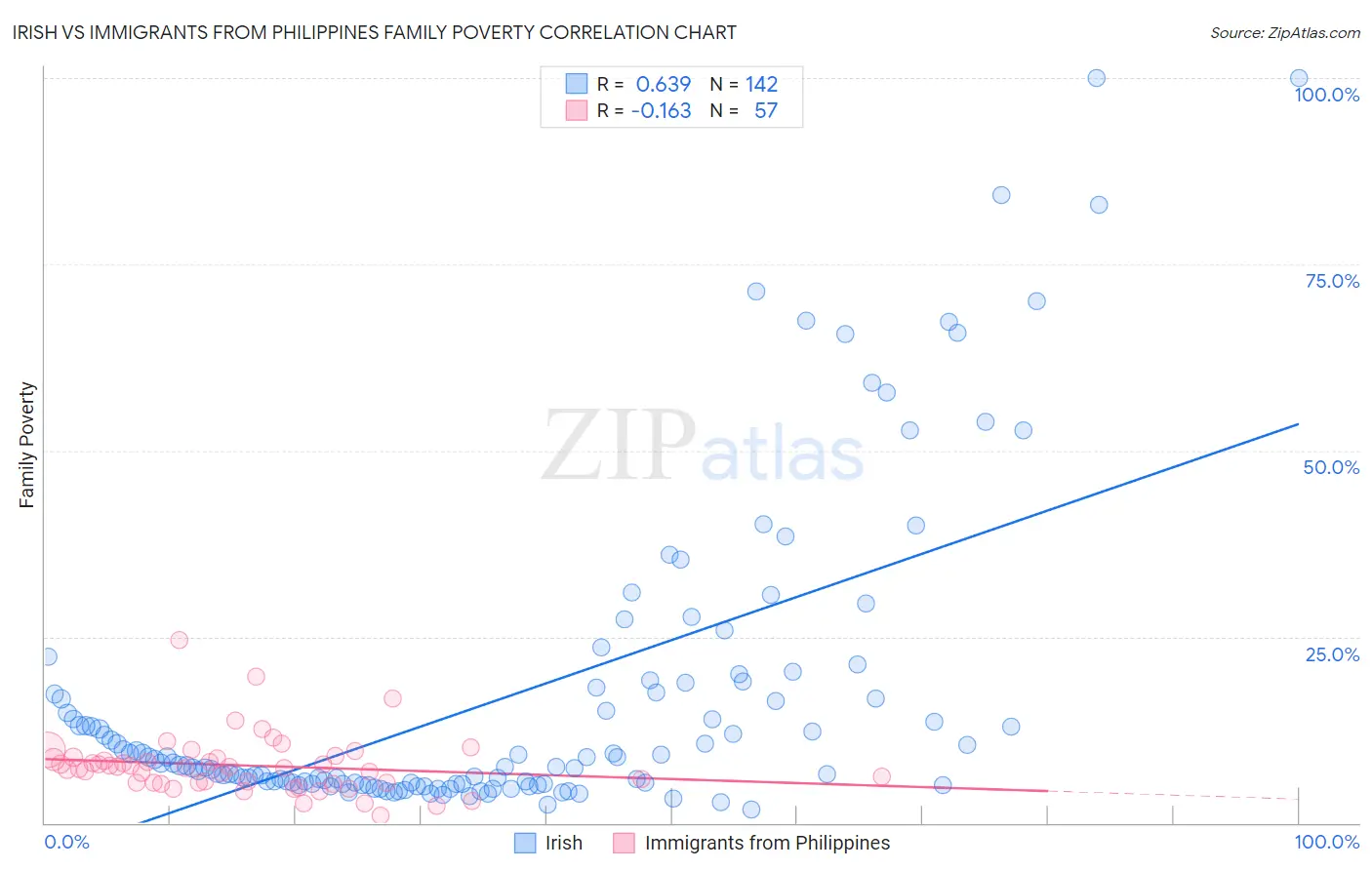Irish vs Immigrants from Philippines Family Poverty
COMPARE
Irish
Immigrants from Philippines
Family Poverty
Family Poverty Comparison
Irish
Immigrants from Philippines
7.9%
FAMILY POVERTY
97.8/ 100
METRIC RATING
81st/ 347
METRIC RANK
8.0%
FAMILY POVERTY
96.5/ 100
METRIC RATING
95th/ 347
METRIC RANK
Irish vs Immigrants from Philippines Family Poverty Correlation Chart
The statistical analysis conducted on geographies consisting of 574,608,080 people shows a significant positive correlation between the proportion of Irish and poverty level among families in the United States with a correlation coefficient (R) of 0.639 and weighted average of 7.9%. Similarly, the statistical analysis conducted on geographies consisting of 469,729,486 people shows a poor negative correlation between the proportion of Immigrants from Philippines and poverty level among families in the United States with a correlation coefficient (R) of -0.163 and weighted average of 8.0%, a difference of 1.8%.

Family Poverty Correlation Summary
| Measurement | Irish | Immigrants from Philippines |
| Minimum | 1.7% | 1.1% |
| Maximum | 100.0% | 24.5% |
| Range | 98.3% | 23.5% |
| Mean | 16.9% | 7.7% |
| Median | 7.9% | 7.4% |
| Interquartile 25% (IQ1) | 5.2% | 5.4% |
| Interquartile 75% (IQ3) | 17.5% | 8.7% |
| Interquartile Range (IQR) | 12.2% | 3.3% |
| Standard Deviation (Sample) | 20.6% | 4.0% |
| Standard Deviation (Population) | 20.5% | 3.9% |
Demographics Similar to Irish and Immigrants from Philippines by Family Poverty
In terms of family poverty, the demographic groups most similar to Irish are English (7.9%, a difference of 0.010%), Immigrants from Poland (7.9%, a difference of 0.030%), Immigrants from Europe (7.9%, a difference of 0.070%), Immigrants from North America (7.9%, a difference of 0.15%), and Slovak (7.9%, a difference of 0.20%). Similarly, the demographic groups most similar to Immigrants from Philippines are Immigrants from Pakistan (8.0%, a difference of 0.010%), Immigrants from Turkey (8.0%, a difference of 0.020%), Tlingit-Haida (8.0%, a difference of 0.12%), Czechoslovakian (8.0%, a difference of 0.30%), and Immigrants from Switzerland (8.1%, a difference of 0.43%).
| Demographics | Rating | Rank | Family Poverty |
| Immigrants | North America | 97.9 /100 | #78 | Exceptional 7.9% |
| Immigrants | Europe | 97.8 /100 | #79 | Exceptional 7.9% |
| English | 97.8 /100 | #80 | Exceptional 7.9% |
| Irish | 97.8 /100 | #81 | Exceptional 7.9% |
| Immigrants | Poland | 97.8 /100 | #82 | Exceptional 7.9% |
| Slovaks | 97.7 /100 | #83 | Exceptional 7.9% |
| British | 97.5 /100 | #84 | Exceptional 7.9% |
| Immigrants | Asia | 97.4 /100 | #85 | Exceptional 7.9% |
| Scottish | 97.3 /100 | #86 | Exceptional 7.9% |
| Belgians | 97.3 /100 | #87 | Exceptional 8.0% |
| Serbians | 97.2 /100 | #88 | Exceptional 8.0% |
| Immigrants | Denmark | 97.1 /100 | #89 | Exceptional 8.0% |
| Immigrants | England | 97.1 /100 | #90 | Exceptional 8.0% |
| Immigrants | Italy | 97.0 /100 | #91 | Exceptional 8.0% |
| Czechoslovakians | 96.8 /100 | #92 | Exceptional 8.0% |
| Tlingit-Haida | 96.7 /100 | #93 | Exceptional 8.0% |
| Immigrants | Pakistan | 96.6 /100 | #94 | Exceptional 8.0% |
| Immigrants | Philippines | 96.5 /100 | #95 | Exceptional 8.0% |
| Immigrants | Turkey | 96.5 /100 | #96 | Exceptional 8.0% |
| Immigrants | Switzerland | 96.1 /100 | #97 | Exceptional 8.1% |
| Immigrants | South Africa | 95.9 /100 | #98 | Exceptional 8.1% |